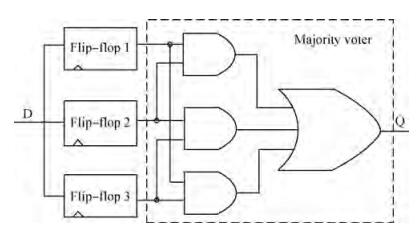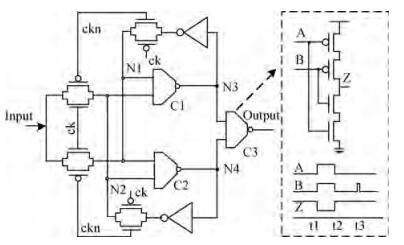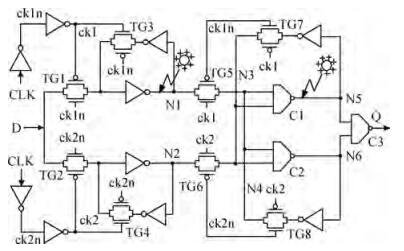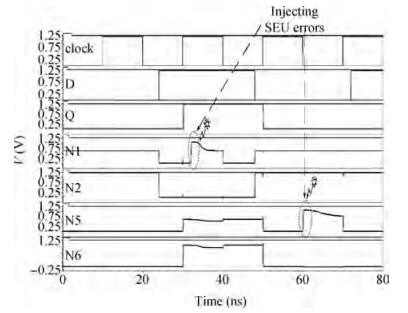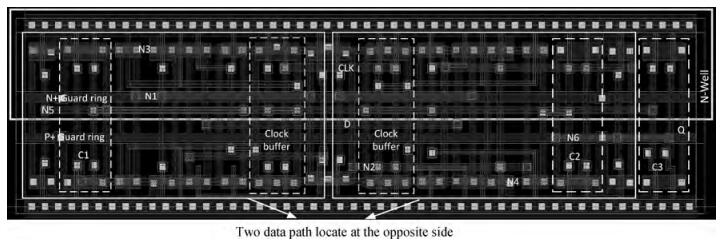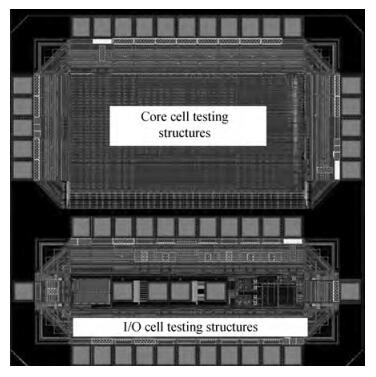| Citation: |
Gang Chen, Bo Gao, Min Gong. A dual redundancy radiation-hardened flip-flop based on a C-element in a 65 nm process[J]. Journal of Semiconductors, 2013, 34(9): 095012. doi: 10.1088/1674-4926/34/9/095012
****
G Chen, B Gao, M Gong. A dual redundancy radiation-hardened flip-flop based on a C-element in a 65 nm process[J]. J. Semicond., 2013, 34(9): 095012. doi: 10.1088/1674-4926/34/9/095012.
|
A dual redundancy radiation-hardened flip-flop based on a C-element in a 65 nm process
DOI: 10.1088/1674-4926/34/9/095012
More Information
-
Abstract
A radiation-hardened flip-flop is proposed to mitigate the single event upset (SEU) effect. Immunity was achieved through the use of C-elements and redundant storage elements. It takes advantage of the property of a C-element in which it enters a high impedance mode when its inputs are of different logic values. Redundant storage nodes are then used to drive the C-elements so that a single upset pulse in any storage will be prevented from altering the state of the output of the flip-flop. The flip-flop was implemented using 48 transistors and occupied an area of 30.78 μm2, using 65 nm CMOS process. It consumed 22.6% fewer transistors as compared to the traditional SEU resilient TMR flip-flop. -
References
[1] Nicolaidis M. Design for soft error mitigation. IEEE Trans Device Mater Reliab, 2005, 5(3):405 doi: 10.1109/TDMR.2005.855790[2] Dodd P E, Shaneyfelt M R, Schwank J R, et al. Current and future challenges in radiation effects on CMOS electronics. IEEE Trans Nucl Sci, 2010, 57(4):1747 doi: 10.1109/TNS.2010.2042613[3] Mavis D, Alexander D. Employing radiation hardness by design techniques with commercial integrated circuit processes. AIAA/IEEE 16th Digital Avionics Systems Conference, 1997, 1:2.1 http://ieeexplore.ieee.org/document/635027/authors[4] She X, Samudrala P. Selective triple modular redundancy for single event upset (SEU) mitigation. NASA/ESA Conference on Adaptive Hardware and Systems, 2009:344 http://dl.acm.org/citation.cfm?id=1673216[5] She X, McElvain K S. Time multiplexed triple modular redundancy for single event upset mitigation. IEEE Trans Nucl Sci, 2009, 56(4):2443 doi: 10.1109/TNS.2009.2021656[6] Wang X. Partitioning triple modular redundancy for single event upset mitigation in FPGA. International Conference on E-Product E-Service and E-Entertainment (ICEEE), 2010, 1:7 http://ieeexplore.ieee.org/document/5660842/authors[7] Oliveira R, Jagirdar A, Chakraborty T J. A TMR scheme for SEU mitigation in scan flip-flops. Proc 8th Int Symp Quality Electronic Design, 2007:905 http://ieeexplore.ieee.org/document/4149148/[8] Golshan S, Bozorgzadeh E. SEU-aware resource binding for modular redundancy based designs on FPGAs. Design, Automation & Test in Europe Conference & Exhibition, 2009:1124 http://dl.acm.org/citation.cfm?id=1874892&dl=ACM&coll=DL&CFID=988920426&CFTOKEN=93551803[9] Rennie D J, Sachdev M. Novel soft error robust flip-flops in 65 nm CMOS. IEEE Trans Nucl Sci, 2011, 58(5):2470 doi: 10.1109/TNS.2011.2162745[10] Mitra S, Ming Z, Waqas S, et al. Combinational logic soft error correction. Proc International Test Conference, 2006:1[11] Fazeli M, Patooghy A, Miremadi S G, et al. Feed-back redundancy:a power efficient SEU-tolerant latch design for deep sub-micron technologies. Proc 37th Annu IEEE/IFIP Int Conf Depend Syst Netw, 2007:276[12] Huang Zhengfeng, Liang Huaguo. A novel radiation hardened by design latch. Journal of Semiconductors, 2009, 30(3):035007 doi: 10.1088/1674-4926/30/3/035007[13] Wu Lihua, Han Xiaowei, Zhao Yan, et al. Design and implementation of a programming circuit in radiation-hardened FPGA. Journal of Semiconductors, 2011, 32(8):085012 doi: 10.1088/1674-4926/32/8/085012 -
Proportional views





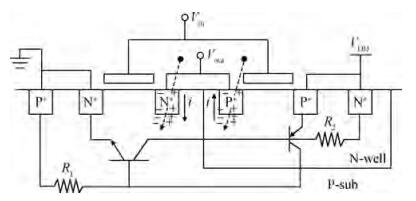
 DownLoad:
DownLoad:
